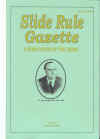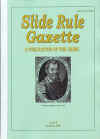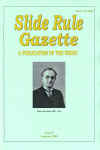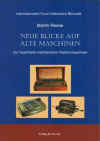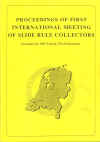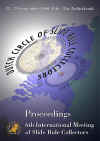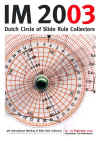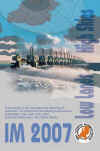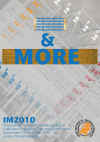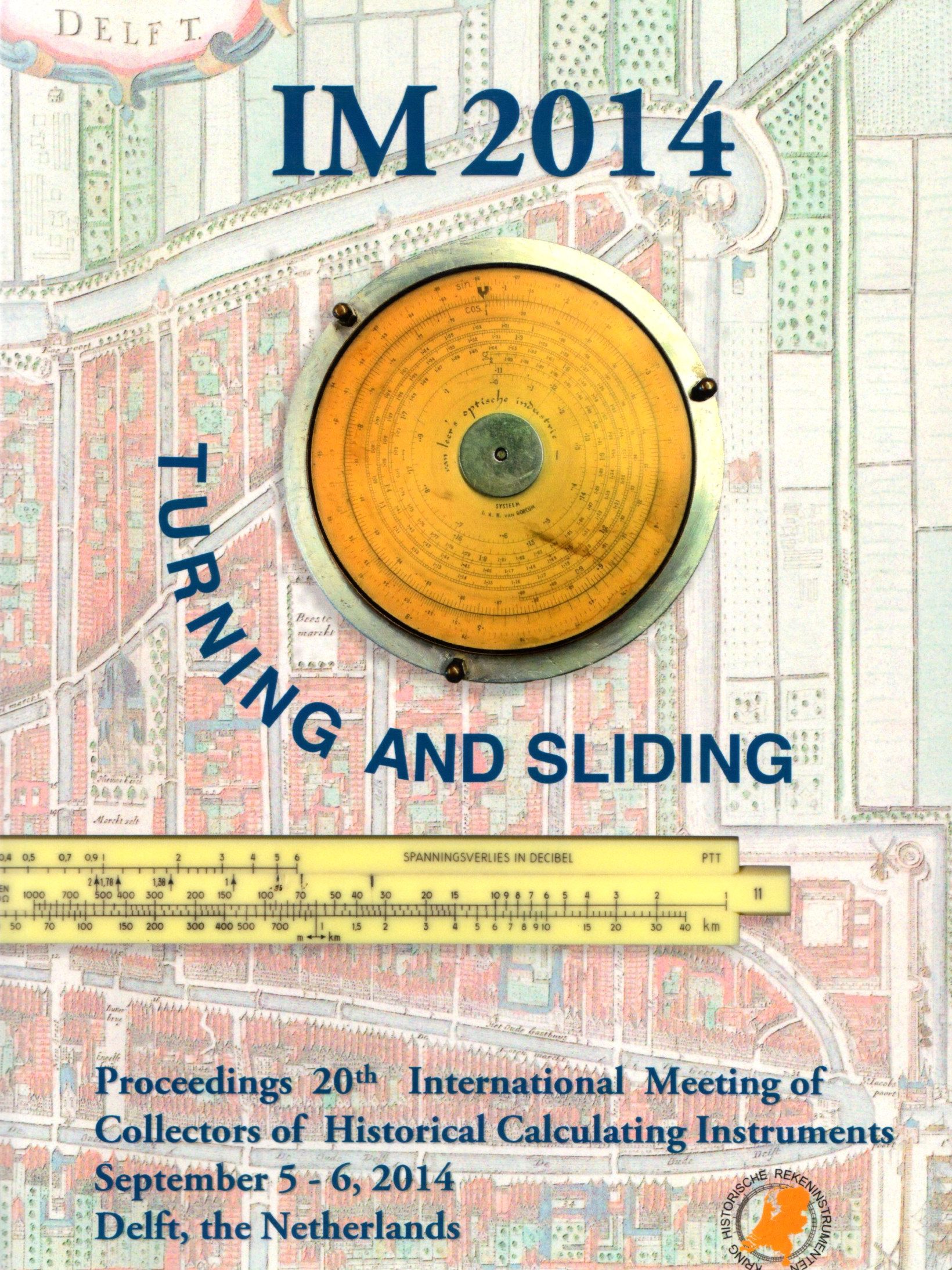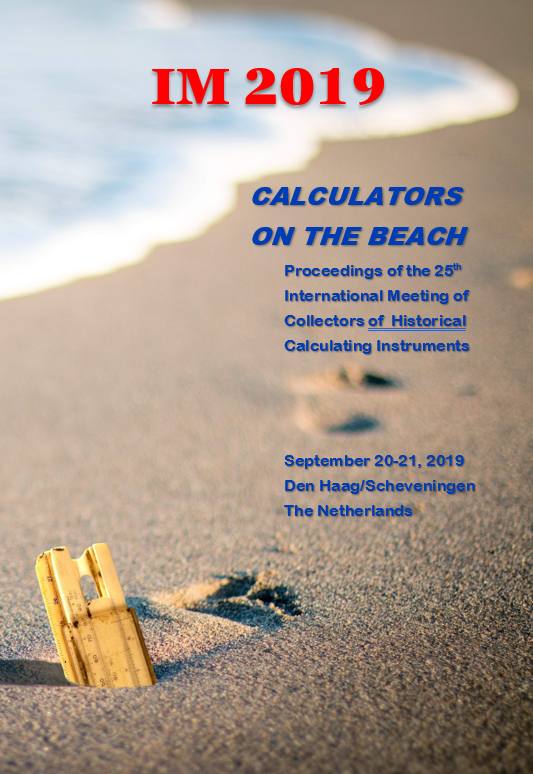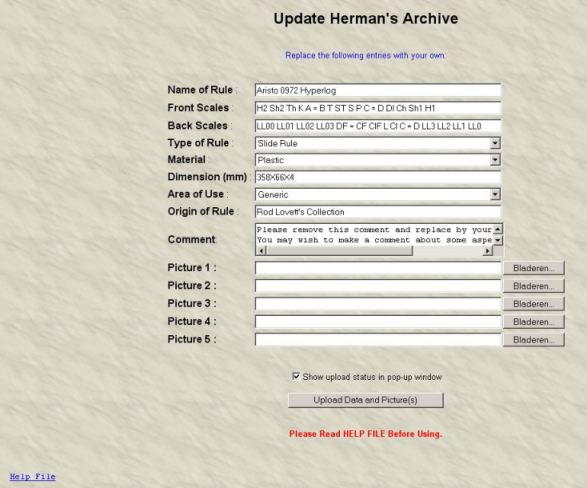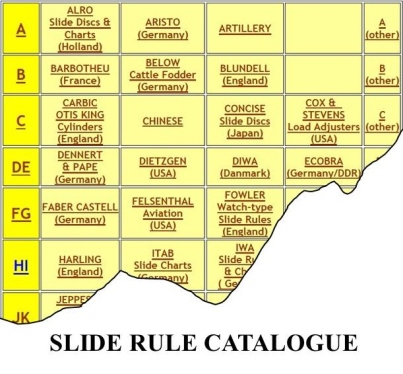Publications about Slide Rules
Some Recommended Books
 Jacques Perregaux:
Der Rechenstab Aristo Studio Typ 968 und 0968 Eine Untersuchung zu seiner Geschichte,
Jacques Perregaux:
Der Rechenstab Aristo Studio Typ 968 und 0968 Eine Untersuchung zu seiner Geschichte,
German language, 2024, 62+10 A4 pages, numerous coloured illustrations, 978-3-033-10520-1.
€ 29.50, including shipping inside the EU.
Information/ordering: jperregaux@bluewin.ch
The Aristo Studio was one of the best-selling technical-scientific slide rules in the period 1950 to 1978.
This booklet describes the history of the manufacturer Dennert & Pape from 1945 to 1949,
shows the development of the new double-sided Aristo Studio, as well as its construction features and changes throughout the production period.
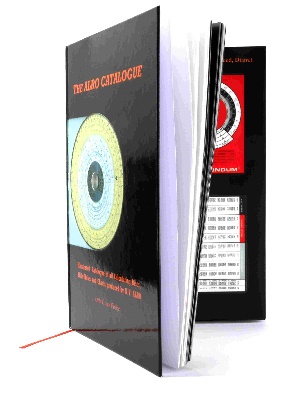 Otto van Poelje:
The ALRO catalogue,
Otto van Poelje:
The ALRO catalogue,
English language, 2020.
€ 35 + shipping costs. More information and ordering.
Featuring for the first time all 52 currently known solid calculating discs and slide rules, plus the over a hundred slide charts, that were produced by the Dutch firm “ALRO” in the city of The Hague, from the mid-1930’s until the late 1990’s.
In a hardback bound A4 book format, with more than 200 pages of descriptions, tabular data, documentary annexes, a new coding system for identification, and most importantly the high-resolution colour images of each and every ALRO that is known today.
 Herbert Bruderer:
Meilensteine der Rechentechnik (3. Aufl.)
Herbert Bruderer:
Meilensteine der Rechentechnik (3. Aufl.)
in German, 2020, 978-3-11-070295-8.
Large overview in two volumes, 2025 pages with more than 700 mages.
See advertisement in MIR 83 p.22
 Ina Prinz (Ed.):
Slide Rules in the Arithmeum: The Schuitema Collection,
Ina Prinz (Ed.):
Slide Rules in the Arithmeum: The Schuitema Collection,
in English language, Nicholaische Verlagsbuchhandlung GmbH, 2014, 978-3-89-479833-8.
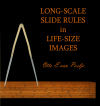 Otto E. van Poelje:
Long-scale slide rules in life-size images
Otto E. van Poelje:
Long-scale slide rules in life-size images
in English language, 2013, available online.
A large "coffee table" book, 30 by 60 cm, which, when opened, showed long-scale slide rules in near real size.
Limited edition, but now available online.
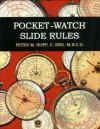 Peter Hopp:
Pocket Watch Slide Rules,
Peter Hopp:
Pocket Watch Slide Rules,
in English language, 2011.
Printed and sold by Astragal Press
From the back cover:
Peter Hopp needs no introduction to slide rule collectors throughout the world.
His first book Slide Rules – their History, Models and Makers, published in 1999, has become the point of first reference for all slide rule collectors.
This work was followed by a detailed study of joint slide rules in his book Joint Slide Rules – Sectors, 2-foot 2-fold and slide rules,
published in 2009.
Drawing on his years of slide rule collecting experience we now have Hopp’s latest extensively researched book Pocket-Watch Slide Rules.
Starting with an analysis of the various types of pocket-watch slide rules, an historic review of the oldest types and patents, the book continues with a review of worldwide manufacture.
A comprehensive survey of pocket-watch slide rules is given by ‘family’ sub-divided with relevant information including some unidentified examples and examples known to exist but as yet undiscovered.
The latter part of the book deals with non-mathematical types of pocket-watch calculators and wrist-watch slide rules.
Finally the book contains a list of known worldwide manufacturers and retailers and an appendix with operating instructions and hints on identifying makers of unmarked versions.
In its non-technical style and logical layout, both the casual collector and the connoisseur will find information and delight in this book covering, as it does, aspects of design and construction from the earliest known examples to the demise of the slide rule in general use.
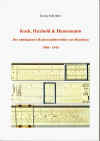 Georg Schreiber:
Koch, Huxhold & Hannemann: der Unbekannte Rechenhersteller aus Hamburg
Georg Schreiber:
Koch, Huxhold & Hannemann: der Unbekannte Rechenhersteller aus Hamburg
in German language, 2011.
Sold by the author: ge.schreib@t-online.de
This book is about a rather unknown manufacturer of slide rules, Koch, Huxhold & Hanneman - “der unbekannte Rechenstabhersteller”.
Georg Schreiber is researcher, author and publisher of this work,
The book contains exclusively new material (in German language, but with many illustrations), and will provide many of us with surprising new information.
Some excerpts from a more extensive review of this book:
…
KHH sold slide rules under their own name, but the vast majority of KHH products bear names of resellers.
This fact makes the identification of the KHH root the more important.
The book gives a number of clearly recognizable signs of origin, such as logos, the cross-section view, multiple slits in the well, and five (or sometimes less) screws in the lower edge for slide tension control.
The most remarkable recognition mark however is the slightly smaller font of the number “23” compared to other numbers in the cm-scale on the bevelled edge….
Other resellers in Europe were Otto Schleiffelder in Austria, Emile Pfenninger & Co in Switzerland, Ahrend and OHICO in the Netherlands, Kahn Frères in Belgium, MDS London in the UK, and …
…
The book further describes the standard types of slide rules produced by KHH:
Mannheim, Rietz (Polyphase for the USA), elektro, commerce, school, and pocket models.
But the “icing on the cake” consists of some 50 pages describing, with many clear pictures, special designs and constructions:
System Cuntz (unique mathematical scales), Dr. Frank …
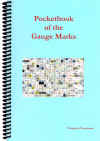 Panagiotis Venetsianos:
Pocketbook of the Gauge Marks, Second Edition
Panagiotis Venetsianos:
Pocketbook of the Gauge Marks, Second Edition
Published by Lulu,
under the aegis of the Oughtred Society, 2011.
This second edition is a substantial extension of the first issue in 2006.
Its size has been increased from 68 to 147 pages, with numerous additions and corrections.
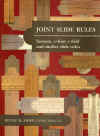 Peter Hopp:
Joint Slide Rules,
Peter Hopp:
Joint Slide Rules,
in English language, private publication, 2009.
Peter Hopp is the well-known author of one of the first modern books on slide rules:
Slide Rules - Their History, Models and Makers, in 1999.
Now he has published a more specialised book on “joint slide rules”.
The scope of this subject may be roughly summarised as “slide rules with at least one hinge”.
Separate chapters explain the detailed workings of “Per Load” tables, Girt lines, “E and M”, Scamozzi lines.
But the major part of the book is dedicated to a large number of actual specimens of joint rules, with many details on hinge construction, slide and scale design, makers and specific applications.
More than 60 colour pictures give the extra information that text alone can not convey.
A separate list of “joint slide rule” makers shows some 200 names.
Peter Holland:
Rechenschieber (Slide Rules), A.W. Faber & A.W. Faber-Castell - Modell, Typen, Skalen (Models, Types, Scales)
in German (and English) language, private publication, 1st edition 2009.
In March 2011 the 4th revised edition of this book was announced.
The 8th edition, from 2022, is available online
This neat little 128-page booklet is an “overview of all slide rules by Faber and Faber-Castell”.
It could also be called a catalogue, and the structure is indeed organized as a tabular list of all Faber-Castell (F-C) slide rule types.
Separate section versions are given in German and in English.
In the tables, however, the language differences are indicated only for each matrix element where needed.
Not only the slide rule tables are important to collectors.
The book also incorporates very helpful tables on the structure of the seemingly haphazard F-C type numbering scheme, the German registration marks nd patents by F-C, and dating methods by construction details, materials used, inscriptions, logos, etc.
Of real practical use for the collector are the equivalence tables of slide rules having the same fit of cursor or the same type of case.
 Klaus Kühn, Rodger Shepherd:
Calculating with Tones: The Logarithmic Logic of Music,
Klaus Kühn, Rodger Shepherd:
Calculating with Tones: The Logarithmic Logic of Music,
in English language, 2009.
Printed and sold by The Oughtred Society, USA
From the introduction we read that this monograph addresses the following questions:
- How is a musical scale constructed?
- What was Pythagoras' contribution?
- How has the "monochord" helped?
- Difference between pure and tempered tuning?
- What is the Pythagoran comma?
- What is the Circle of Fifths?
- What is the Weber-Fechner Law?
and many other questions and issues about the relation between logarithms and music.
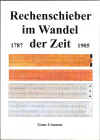 Guus Craenen:
Rechenschieber im Wandel der Zeit, 1787–1905
Guus Craenen:
Rechenschieber im Wandel der Zeit, 1787–1905
in German language, private publication, 2009.
Sold by the author but no longer available.
Spanish and English translations are available for download.
The third book by Guus Craenen addresses the history of the slide rule from 1787 to 1905, emphasizing the developments around the system Mannheim and subsequent models by Dennert & Pape and Nestler, all from the perspective of the Industrial Revolution in the Europa of that age.
This approach reacquaints the reader with subjects from the first two books by Guus.
The newly added information and the ever increasing quality of the pictures make this new book valuable.
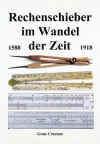 Guus Craenen:
Rechenschieber im Wandel der Zeit, 1588–1918,
Guus Craenen:
Rechenschieber im Wandel der Zeit, 1588–1918,
in German language, private publication, 2011.
Sold by the author but no longer available
This fourth book by Guus Craenen describes the history of the slide rule from 1588 to 1918, a more extended period than the era 1787–1905 in his third book.
It contains as new elements the forerunners of the slide rule in the 16th and 17th century: introductions to the invention of the logarithm, the Gunter rule, sector (proportional compasses), and reduction compasses - including a 20th century version by Weems & Plath for time-speed-distance calculations. Many slide rules that we know from earlier books by Guus are treated again, often with new and better pictures, or with new information.
New types are introduced: the Polymeter van Stöckle (1843), the early loglog System Schweth by D&P (1900), the Faber-Castell 347 Stahlbau System Schweppe-Äbli, and the planimeter for measuring and calculating areas on drawings.
As always in the books by Guus, many annexes are attached with sources, names, corrections in earlier books, patents, etc.
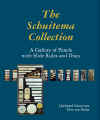 IJzebrand Schuitema (Auth.),
Otto van Poelje (Ed.):
The Schuitema Collection,
IJzebrand Schuitema (Auth.),
Otto van Poelje (Ed.):
The Schuitema Collection,
in English language, private publication, 2009.
Printed and sold by Lulu.com
From the back cover:
The Schuitema Collection
Illustrated Catalogue of all slide rules and discs in the Schuitema Collection.
In December 2008, this private collection was donated by IJzebrand Schuitema to the Arithmeum museum in Bonn, Germany.
The book presents the Schuitema Collection at that moment, structured in 55 themes and displayed on 188 panels.
Some 2700 panel objects are presented in pictures and text.
IJzebrand's donation of his collection to the Arithmeum has been reported in MIR49 articles.
This book on the Schuitema Collection is described in more detailed in
the announcement in MIR 50.
A preview is possible for the introduction
and for three selected panels.
The book can be ordered in paperback or in hardcover binding.
Because a printed copy of the book with 400 colour pages is very expensive (between 73 and 95 euro depending on binding and shipping),
there is also an option for a free download of the PDF file.
The book is organized by themes and panels.
To look where a specific brand name and model type can be found in the Schuitema Collection, please click at this alfabetical Index of Items.
 Kring Historische Rekeninstrumenten:
KRING Jubileum DVD, 1992 - 2017
Kring Historische Rekeninstrumenten:
KRING Jubileum DVD, 1992 - 2017
Private publication, 2017.
The contents of the DVD celebrating 25 years of the KRING is now freely available online.
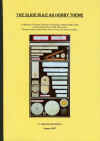 IJzebrand Schuitema:
The Slide Rule as Hobby Theme,
IJzebrand Schuitema:
The Slide Rule as Hobby Theme,
Private publication, 2007
IJzebrand Schuitema's third book — in English — recounts personal experiences during his more than 25 years of collecting slide rules.
Every collector will recognize events and situations in this book, but also he will find ideas to initiate new activities in his collecting activities.
The reader will become more closely acquainted with IJzebrand while reading his book.
IJzebrand wants to put an example with his book, for other
collectors to put their own experiences to print.
This book has been printed in limited numbers, for friends only.
There will be no reprint because of high colour printing costs.
However the book can be obtained in digital format as part of the KRING Jubileum DVD, see description above.
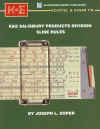 Joseph L. Soper:
K&E Salisbury Products Division Slide Rules,
Joseph L. Soper:
K&E Salisbury Products Division Slide Rules,
Published by the Oughtred Society, 2007
Joseph L. Soper joined K&E in 1966, training at the Hoboken facility and then moving to the Salisbury Products Plant in Lakeville, Connecticut.
At Salisbury he progressed from Department Supervisor, to Plant General Foreman, to Production Manager, and then to Plant Manager, a total of twenty-nine years.
This book is a story told by Joe Soper just like he was sitting in your living room just talking to you.
The story is packed with lots of human interest while telling many details of slide rule production at the Salisbury plant.
There is something for everybody.
How plastic slide rules were made by K&E is the main theme but along the way there are many details about how the scales were laid out,
how the molding masters were made and many production details.
The bizarre story about the Analon is finally told by someone that was there.
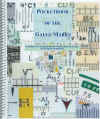 Panagiotis Venetsianos:
Pocketbook of the Gauge Marks,
Panagiotis Venetsianos:
Pocketbook of the Gauge Marks,
Published by the Oughtred Society, 2006
This booklet was produced exclusively for Oughtred Society members.
It was sent to all members with the second issue of the Journal of the Oughtred Society in 2006.
It will also be sent to new members joining the Society, while the stock lasts.
See http://www.oughtred.org/members.shtml
What is the difference between a slide rule and a table of physical & mathematical constants?
First the similarity: slide rules also have constants imprinted, the so-called “gauge marks”.
Of the many differences, an outstanding one is that a constant on the slide rule is immediately available for use in a calculation.
Unit conversion is one of the possible applications, but many other ingenious factors have been invented to ease specific calculations.
An individual slide rule may have a small number of constants – excepting specials like for instance the chemical rule bearing quite some elements from the Periodic System.
However, many slide rules collectively make up a substantial book of constants.
And that is exactly what Panagiotis Venetsianos has achieved over the more than 10 years that he is collecting gauge marks.
For collectors and connoisseurs alike, this booklet is a goldmine of information, to understand and appreciate the sometimes cryptic icons on their slide rules.
The elegant design of cross-referencing tables for gauge mark names and their numerical values - with explanations - allows an easy answer to any question on the gauge marks.
The Oughtred Society considered this work important enough to have this booklet produced in print for the members of the Society.
Dutch Kring members may have seen a preliminary version of this text in
MIR 29, October 2001.
In 2011 an extended 2nd edition was published.
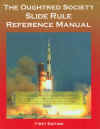 Ted Hume, Bob Koppany (Ed.):
The Oughtred Society Slide Rule Reference Manual,
Ted Hume, Bob Koppany (Ed.):
The Oughtred Society Slide Rule Reference Manual,
Private publication, 2005
A beautiful 100-page guide for the slide rule collector, in a striking lay-out with full colours.
The book is written in English, and is lavishly adorned with full pictures of both American and European slide rules.
History, principles, usage and many tips for the collector of slide rules are exposed in clear language with many examples.
 Klaus Kühn, Karl Kleine:
Dennert & Pape, ARISTO 1872 - 1978, with 2 CD-ROMs
Klaus Kühn, Karl Kleine:
Dennert & Pape, ARISTO 1872 - 1978, with 2 CD-ROMs
Zuckschwerdt Verlag, 2004, 3-88603-863-7.
Instead of the usual Proceedings, a bound book of more than 400 pages was published at the IM2004 in Germany, to which a large number of authors contributed.
In addition, an impressive collection of source material is presented on 2 CD-ROMs containing translations into English, catalogues, patents, manuals, learning materials, information, etc.
This book contains everything there is to know about Dennert & Pape and Aristo.
The book is in German language, but most of the material is also available in English.
For more information about this book, visit IM2004.
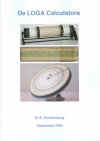 Nico Smallenburg:
De LOGA Calculators,
Nico Smallenburg:
De LOGA Calculators,
Private publication, 2004. Available online
Almost 200 pages about one brand, LOGA, plus a CD with colour pictures of all known LOGA Calculators.
Backgrounds of the firm LOGA, the Dutch representative, product survey of all LOGA calculating drums and discs, patents, brake systems, manuals and maintenance are treated extensively.
The book is written in Dutch, but the 17 page "English introduction" (plus 17 page "Deutsche Zusammenfassung") and the many pictures make this book also worthwhile for English and German readers.
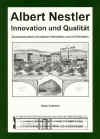 Guus Craenen:
Albert Nestler - Innovation und Qualität Teil II, Zusammenarbeit mit anderen Herstellern und mit Erfindern,
Guus Craenen:
Albert Nestler - Innovation und Qualität Teil II, Zusammenarbeit mit anderen Herstellern und mit Erfindern,
Private publication, 2004
Sold by the author but no longer available.
This sequel to Part I provides new information on Nestler, which was obtained recently,
and treats in more detail the cooperation between Nestler and other slide rule manufacturers, both within and outside of Germany.
Many slide rules, resulting from such cooperations, are described extensively.
This richly illustrated book contains almost 100 pages to complete the history of the Nestler firm.
 Ir. IJ. Schuitema:
The Slide Rule, Technical Cultural Heritage,
Ir. IJ. Schuitema:
The Slide Rule, Technical Cultural Heritage,
Private publication, 2003
This new book, in English, by IJzebrand Schuitema addresses over 130 patents, mainly European, and gives descriptions of more than 30 specialised slide rules from his own collection.
With some 500 pictures, many of them in colour.
Also a CD-ROM is included with detailed pictures of all addressed slide rules.
See the English-language review of this book in MIR34.
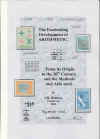 Jo Donners (1937 - 2005):
Mijnheer van Dalen Krijgt Antwoord,
Jo Donners (1937 - 2005):
Mijnheer van Dalen Krijgt Antwoord,
Dutch version self published in 2002
English (extended) version The Fascinating Development of Arithmetic
has been presented at IM2003, and is available from the author.
A summary of the history and development of arithmetic from the Egyptians into the 20th century, and the tools used.
The title refers to a Dutch memory aid used at school for remembering the priority rules of calculation operators,
comparable to the "My Dear Aunt Sally" rule.
The book is written in a compact manner, with much information on arithmetic in various civilisations (Egypt, Mesopotamia, Greece, Rome, Western Europe, India, Arabia, Chine, Japan,
the Maya’s and Inca’s),
and about practical calculation tools (calculating by fingers, exchequer tallies, Napier and Genaille bones, logarithms, slide rules and mechanical instruments).
Highly recommended for the slide rule collector with a wider interest.
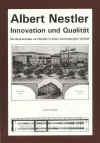 Guus Craenen:
Albert Nestler - Innovation und Qualität,
Guus Craenen:
Albert Nestler - Innovation und Qualität,
Private publication, 2001
Sold by the author but no longer available.
One of the best-known manufacturers in Germany, Nestler, is the subject of study in this more specialised book.
Next to information on production and models, this book also supplies some insight into the human interest of the Nestler family, together with the context and circumstances of that era.
The large number of figures (over 130) brings this book really to life.
The many addenda provide extensive reference material in lists and tables.
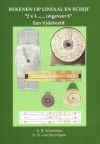
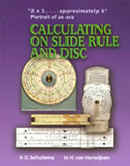 Ir. IJ. Schuitema,
Ir. H. van Herwijnen (1929–2004):
Rekenen op liniaal en schijf, "2 x 3 ...... ongeveer 6", Een tijdsbeeld,
Ir. IJ. Schuitema,
Ir. H. van Herwijnen (1929–2004):
Rekenen op liniaal en schijf, "2 x 3 ...... ongeveer 6", Een tijdsbeeld,
Private publication, 2000
Addresses 11 Dutch slide rule designers and producers, and some other slide rule models.
The information presented has been mainly acquired by conversations and correspondence with the directly involved persons or family. ("oral history").
Also some sections cover the collecting of slide rules, and a CD-ROM has been added containing over 500 striking pictures of the slide rules that are addressed in this book.
This book has been issued in a Dutch, but also in an English
version: Calculating on Slide Rule and Disc, "2 x 3 ...... approximately 6", Portrait of an era
The English version is available at The Astragal Press
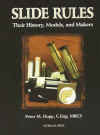 Peter M. Hopp:
Slide Rules - Their History, Models, and Makers,
Peter M. Hopp:
Slide Rules - Their History, Models, and Makers,
The Astragal Press, 1999, 1-879335-86-7.
Comprehensive reference book with many tables on models and makers world-wide.
Includes unique information about English instrument makers before the 20th century.
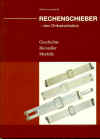 Dieter von Jezierski:
Rechenschieber - eine Dokumentation,
Dieter von Jezierski:
Rechenschieber - eine Dokumentation,
Private publication, 1997
Very readable and accomplished book covering a broad range of the area.
Especially recommended for the starting collector, in German.
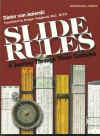 Dieter von Jezierski:
Slide Rules, A Journey Through Three Centuries,
Dieter von Jezierski:
Slide Rules, A Journey Through Three Centuries,
The Astragal Press, 2000, 978-1-87-933594-3.
English-language edition of above-mentioned book from 1997, with many improvements and additions.
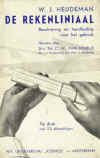 W.J. Heijdeman:
De Rekenliniaal,
W.J. Heijdeman:
De Rekenliniaal,
N.V. Uitgevers-mij. KOSMOS, Amsterdam, many reprints, around 1940
Many books with a more general description and operating techniques have been published in addition to the User Manuals bundled with the slide rules.
As example, this easy booklet was very popular at the time in the Netherlands.
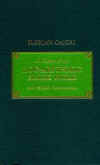 Florian Cajori:
A History of the Logarithmic Slide Rule,
Florian Cajori:
A History of the Logarithmic Slide Rule,
originally published in 1910, Reprint by The Astragal Press, 1994, 978-1-87-933552-3.
This book set a standard at the time, with many details from the early history of the slide rule, including a wealth of source references.
Some other interesting books:
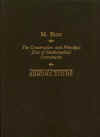
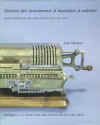
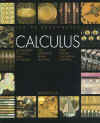



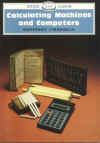
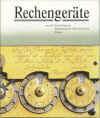
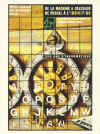
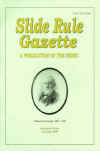
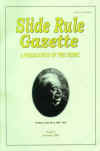
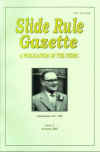
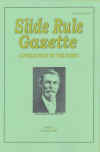
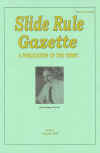
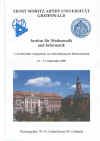
MIR 37
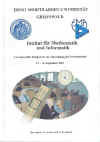
MIR 36
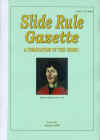
contents
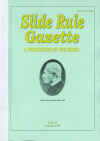
contents
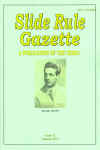
contents
Proceedings “International Meetings of Slide Rule Collectors”
Since 1995 an “International Meeting for Slide Rule Collectors” (IM) has been organised every year in Europe.
Proceedings have been published for each IM, documenting all presentations given.
(see also an overview of all IM's in the past).
The Dutch Circle has organised this Meeting already seven times:
Online Fora
Slide Rule Catalogue & HERMAN's ARCHIVE
From the early 1990's Herman van Herwijnen, member of the Dutch Circle, has worked on his
Slide Rule Catalogue project, with the aim to produce a book (Blue Book) with descriptions of all slide rules known within the Dutch Circle.
As the project progressed, the goal expanded into a computer based database with pictures in colour
of each slide rule. In 2003 the Catalogue database contained more than 5000 slide rules with over 3000 pictures.
Since Herman van Herwijnen died in August 2004, the Catalogue has been frozen in its last version 5.3 of September 2003.
During 2005 - 2006 this consolidated version - with Diny van Herwijnen's approval - was split into a "TEXT Version" and a "LITE Version" with pictures (still available in this website below).
2007: HERMAN's ARCHIVE (living database by Rod Lovett)
In 2007 Rod Lovett, of the UK Slide Rule Circle, has given a new direction to Herman's Slide Rule Catalogue, by creating a new online database, following the data structure of the Catalogue but using a new user interface that had already proven its power in Rod's earlier databases.
In commemoration of Herman, Rod named his new database HERMAN's ARCHIVE.
Usage of HERMAN's ARCHIVE is easy by a help page and by the design of the user interface, see pictures.
2005: “TEXT Version”
The FREE “TEXT VERSION” of the frozen Catalogue of 2003 is available for downloading in the public domain.
This “TEXT Version” (without pictures) is derived from the original Catalogue.
The text table in Microsoft format allows the user to make a hard copy, or to use the electronic version on the screen of PC, or laptop, to look up (un)known slide rules or to administrate one's own collection in the reserved free space of the "Text Version".
See the first eight pages for a first impression.
Download the WORD file of the complete text version.
2006: “LITE Version” (of the frozen Catalogue)
The FREE “LITE VERSION” of the frozen Catalogue of 2003 is available for viewing in the public domain.
This version with 2400 pictures is derived from the “TEXT Version”.
A Full List of all 2400 items can be accessed in a separate window.
